The eLearning industry is booming. More and more people are now pursuing education through online courses. Currently, the industry is now worth at least $250 billion.
This number will increase even further. Some research indicates that eLearning may become a $500 billion industry in 2026.
Hence, if you possess outstanding skills in any field, you may want to ride the trend by sharing your knowledge with other learners through online courses.
Many instructors have made tens of thousands of dollars per year this way. Some even make their income many times above that.
Online courses can become assets that provide you with a reliable passive income. Thus, you don’t need to risk their money in volatile financial markets just to receive a 3% dividend again.
Furthermore, if you have other businesses, creating excellent online courses can generate hundreds or even thousands of high-quality leads as your students may trust your expertise more than others and become your customers.
Some may wonder if creating a top-notch online course would be too difficult. I admit it requires some skills and commitment. However, with the emergence of online course builders and supporting tools, the process has become easier than ever.
Still, this does not mean that you should create online courses using any random online course builder.
This is because, despite your immense commitment, a course created from low-quality software can be substandard, as it may lack essential features that learners look into.
As a result, the reviews will not be positive, and the sales will be meager, if there is any at all. You will then waste your time and resources to no avail.
This is why I decided to do the heavy lifting for you. This post will only feature online course creation software that works in 2024. You can then comfortably choose the one that fits your budget and preference.
Affiliate Disclosure: This post from Victory Tale contains affiliate links. If you subscribe to an online course platform through them, we will receive a small commission from its providers.
Nevertheless, we always value integrity and prioritize your audience’s interests. You can rest assured that we will present each software truthfully.
Things You Should Know
Below is some information that you might want to grasp before proceeding to the software. I recommend reading it before making decisions.
There are two major ways to create and sell online courses.
The first method is straightforward. You will create, host, and sell online courses through an online course builder or platform such as Teachable or Thinkific. I will cover this kind of software in detail in this post.
The second method is to create videos and sell them on the best online learning platforms or online course marketplaces like Udemy and Skillshare.
Both methods have their strengths and weaknesses as follows.
Flexibility and Features
Self Hosted – You will host everything on your domain. Thus, you will have complete freedom and flexibility in creating courses. You don’t need to abide by platform rules.

In addition, you can create online courses in any format, including video, audio, text, interactive, or whatever you can think of.
Online course builders will provide various features to help you unleash your creativity in online course creation, manage student progress, monitor your finances, market your product, and many more.
Online Course Marketplace – You will upload your online course to the platform. Hence, like Youtubers, you will need to abide by the marketplace rules.

For instance, Udemy will not allow instructors to publish courses on dating and relationships. If you violate their terms and conditions, they will remove your courses from their platform.
Also, your course needs to pass the quality review process before being able to sell in the marketplace.
Most importantly, all marketplaces require you to create a video course, which may not be desirable for some instructors. Suppose you want to create text-based training. Publishing it through an online course marketplace is not going to be viable.
Regarding features, these marketplaces only provide the basics, thus severely limiting customization. You cannot offer a customized learning experience to each student.
Bottom Line: Self-hosted option wins.
Technical Performance
Online course builders will equip with the best resources available. Your courses will be on a highly reliable cloud hosting platform, albeit with limited, shared resources.
Though the technical performance for the self-hosted course will be excellent, I don’t think it can match the best online course marketplace as the latter utilizes enterprise-level resources.
Another clear advantage of an online course marketplace is that you don’t need to worry about technical problems at all. Their engineers will fix all of them behind the scenes.
Alternatively, if you choose the self-hosted option, you might need to fix the problem on your own or ask the support team for help.
Bottom Line: Online course marketplace wins.
Marketing
Self-Hosted – You will have to market your course on your own. As you will own a website along with the online course, you can advertise it through social media ads, PPC ads, or write SEO-optimized posts for your blog. Alternatively, you can create podcasts and Youtube videos to create awareness.
This means that you need to allocate some budget for marketing as well. However, with this option, you can build your own brand to target high-end learners or distinguish your courses from competitors.
Online Course Marketplace – A online course marketplace is an Amazon of online courses. Once you pass the approval process, your course will be visible and purchasable to all students through on-platform searches.
If your course ranks high on its search results, you can get thousands of new students without spending a dime on marketing.
However, keep in mind that numerous courses are competing for top spots. Many already receive excellent reviews from real students. As a newcomer, it is highly challenging to beat them.
In addition, it is tough to build your brand if you choose this option. Despite course quality, most online courses listed on such marketplaces do “look cheap.”
Based on my experience as an online course reviewer, I found out that the reason is that only a tiny percentage of available courses are of high quality.
Also, the fact that marketplaces allow learners to purchase or even access unlimited courses at a very low price makes that “cheap appearance” even worse.
Hence, if you want to create a premium online course business or establish an online school, I don’t think publishing courses on online learning platforms will be your best bet.
Bottom Line – Tie
Pricing, Income, and Expenses
Self-Hosted – You can set up your pricing model. You can ask learners to pay a one-time fee or a monthly subscription. You can adjust the price and give out discounts as you wish.
Most significantly, you don’t need to share your income with the builder platform. You will get 100% of the course fees your student paid.
Regarding expenses, you certainly need to subscribe to online course builders (starting at around $29-$99 per month) and pay the processing fees (about 2%-4% to Stripe or PayPal.)
Online Course Marketplace: Leading online course marketplaces charge nothing. However, you need to accept their revenue-sharing plan. In Udemy’s case, you will receive only 37% of course fees.
In other words, if a student purchases a $100 course, you will receive only $37.
Most platforms allow instructors to specify the price for each course. However, if you set it too high above other competitors, very few students will pay for it, especially if you sell online courses on platforms known for inexpensive courses.
To conclude, you will receive more income per course from the self-hosted option. However, this does not mean that your net profit will be higher.
This is because you might be able to generate far more sales on the online learning marketplaces, especially if one of your courses becomes highly popular. I have seen several instructors who have achieved over 1 million course sales on Udemy alone.
Bottom Line: Tie
Which One is Better?
As mentioned above, both options have pros and cons. I think it is subjective in this case.
Before making decisions, you should evaluate your goals, preferences, targeted learners, marketing strategies, budgets, and other factors. If possible, I highly suggest you conduct market research.
To give you an idea, below are my personal opinions.
Suppose you:
- have a limited budget, time, and resources
- don’t care much about branding or flexibility
- believe that the course you plan to create has a solid public demand
You should choose to create and publish your course on the best online learning marketplaces such as Udemy.
In all other cases, you should use one of the best online course platforms (see below).
Criteria for the Best Online Course Builders
Below are my criteria for the best online course builders.
- User-friendly platform with no clunkiness
- Easy to use
- Offer numerous useful features and eLearning assets
- Various pricing options (one-time, subscription, etc.)
- Provide excellent value for money
- Can integrate with other software
- Support multiple payment methods
- Mostly positive reviews from real users
- My personal experience with the platform (if any) must be positive.
Best Online Course Platforms
1. LearnWorlds
LearnWorlds is another online course software that you can safely rely on. In addition to regular course creation features, LearnWorlds offers many more that can enhance your productivity, speed up the process, and improve the overall quality of the lessons you create.
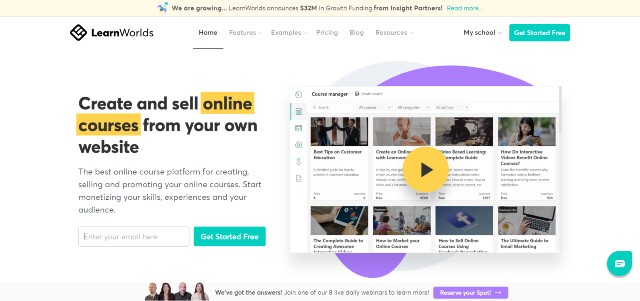
Key Features
Unlike other platforms, LearnWorlds’ users cannot have a “free forever” account. However, you can start a 30-day free trial to try all the features on the platform.
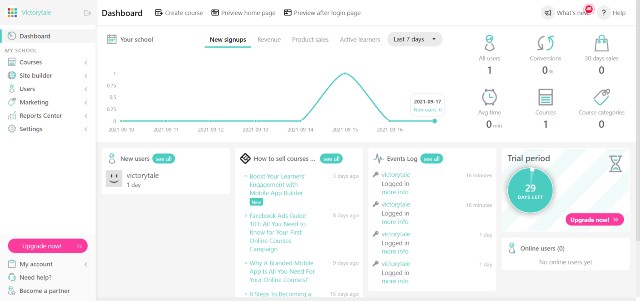
Curriculum Builder – You can easily create a curriculum for any course with LearnWorlds. You can add any type of learning asset or multimedia, including Zoom live sessions, in one click.
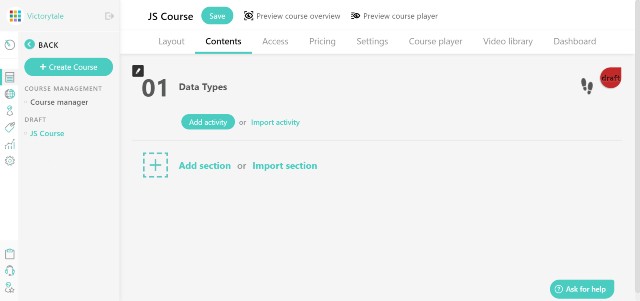
Interactive Video – What makes LearnWorld shine is a video learning platform. Once you upload the video to the platform, you can add interactions to it. These include but are not limited to questions, pointers, overlay images, links, and many more.
As a result, your video lessons will be much more vivid and engaging. All students will have a much more engaging learning experience.
Automatic Transcript – You can also show an automatic transcript (Learnworlds automatically extracts it from the video) on the student’s screen. This will help students navigate and catch up with the content of the course.
Assignments – With LearnWorlds, you can add the most varied types of assignments, ranging from multiple choice quizzes, open-ended questions, exams, and projects. Thus, you will have the flexibility to create a course material of your own choice.
Question Banks – Test prep providers such as Kaplan provide thousands of questions for students. LearnWorlds can help you do the same!
With this feature, you can add a massive pool of questions, and LearnWorlds will automatically create randomized practice tests for students.
Drip Feed – Like other tools, you can adjust lesson delivery to control all students’ pace.
Note-taking and Highlights – Students can highlight and add notes to the text-based lesson. This feature will help your students in reviewing what they have learned.
Learning Communities – You can create a learning community for your learners to chat, exchange opinions, and ask questions. Each learner will have a public profile, hence providing networking opportunities.
Site Builder – You can build a website and landing pages to provide information and generate course sales. The process is straightforward. Just select one of the pre-built templates and customize it using a drag & drop editor. Your site will be ready in no time.
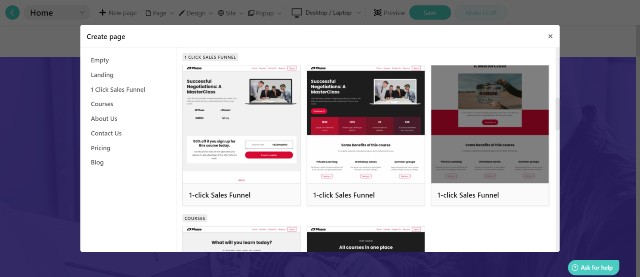
LearnWorlds allows users to add more elements to each webpage than most other tools. You can add interactive content to your sales funnel, such as pop-ups, countdown timers, animations, etc. in one click. Such content will make your site more vivid and generate more conversions.
Custom Domain – You can use a custom domain for your website and course.
Adaptive Content – You can create sections and widgets based on visitor data. For example, you can use it to offer extra discounts to existing students on the landing page. Those who are not students will not be able to see this section and access the discount code.
Marketing Tools – LearnWorlds puts a full suite of marketing tools at your disposal. You can create an affiliate program, change pricing options, give out coupons and discounts, and many more.
Unlike most tools, you can sell your courses in multiple currencies of your choice.
Reports & Insights – LearnWorlds is a tool that provides more actionable insights than others. Apart from regular reports, the platform reveals actionable insights such as student content consumption patterns and recommendations that you can implement to optimize your content.
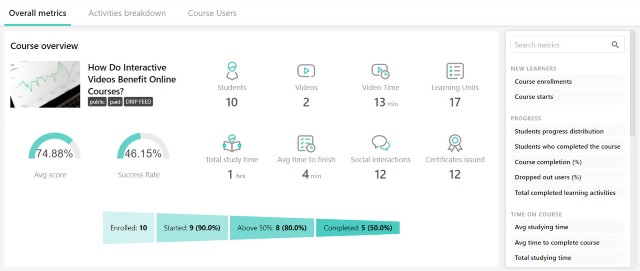
Step-by-step Guidance – LearnWorlds provides a checklist that guides you through the course creation process. The checklist will have the information you need and short explanation videos.
Integrations – You can connect your online school with other software through native or Zapier integration.
You can create a free account to try LearnWorlds for free for 30 days.
Pricing
As mentioned above, LearnWorld does not offer a free plan. If you want to use its online course platform, you will need one of the paid plans below (all pricing below is for annual plans).
- Starter – $24 per month
- Pro Trainer – $79 per month
- Learning Center – $249 per month
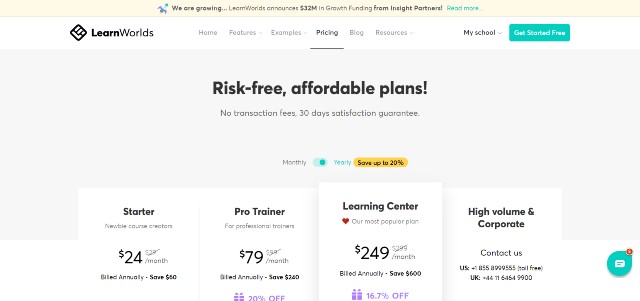
First of all, you should avoid subscribing to the Starter plan. Though the plan looks inexpensive, you will need to pay a $5 fee per course sale and cannot access essential pricing options (subscriptions, installments) and features (live classes, advanced assignments) at all.
The plan that you should subscribe to is the Pro Trainer plan. You will then gain access to all essential features and pay no transaction fees. This plan is more than sufficient for most instructors to create a high-quality course.
However, if you aim to create a premium online course that trumps most competitors, the Learning Center plan will be necessary, as its users can access all advanced features, including the following.
- Interactive Videos
- Automatic Transcript/Subtitles
- Mobile Apps (iOS/Android)
- Detailed Analytics
- Advanced integrations
With these features, your course can then compete head-to-head with leading course providers.
Pros and Cons
Pros
- The best platform to create interactive online courses, particularly video lessons
- Provide several interactive tools that help bolster student engagement and improve the learning experience
- Modern user interface with no trace of clunkiness
- Unlimited courses and students
- Instructions can upload more varied assignments (including open-ended tasks and projects) and even create a question bank.
- Create apps (iOS and Android) for your online courses
- Sell courses in multiple currencies.
- Extremely flexible course management system
- Zapier Integration
- SCORM-compliant
Cons
- No free plan, but a free trial is available (no credit card required).
- To use advanced features, you need to subscribe to the Learning Center plan ($249 per month).
- The tutorial is not very engaging.
2. Thinkific
Thinkific is a market leader in this highly competitive space. The software allows everyone to create courses and sell them to the public with ease. If you are looking for an online course creator, I do not doubt that Thinkific is one of the best you could find.

Key Features
Online Course Builder – Thinkific’s course builder allows instructors to create a top-notch curriculum with ease. You can add more than a dozen types of lessons, including live lessons, video, text, multimedia, presentations, surveys, exams, and many more.
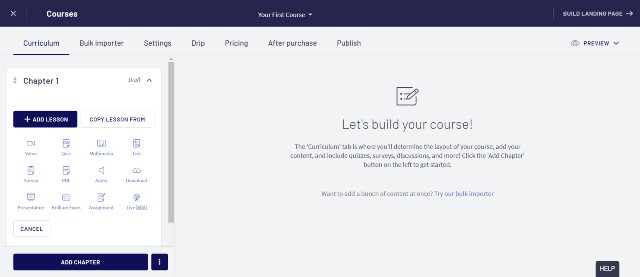
Thinkific already provides a foundational curriculum structure. What you need to do is add your lessons or assignments and customize the conditions (make it a preview lesson, a prerequisite for later lessons, or downloadable, etc.)
For example, I added a new text-based lesson below.
If you have already created some videos, you can use the bulk importer to import them to the platform.
Drip Schedule – This feature will restrict access to parts of the course until the specific date that you have set. You can use it to limit the number of viewable lessons in a certain period, effectively controlling students’ pace in the process.
Progress Tracker and Online Certificate – You can add a progress tracker for all students to track their progress in the course. Once they complete the course, you can send them the online certificates.
Communities – You can create an online community for students to ask questions and communicate with one another. Furthermore, you can even use it to provide personalized feedback to student projects.
Site Builder – You can create landing pages and other web pages that accompany your course by using pre-built themes and a drag and drop editor.
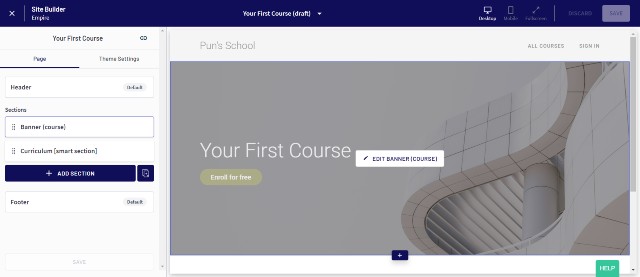
Thinkific allows full customization of all elements, including colors, typography, styles, and many more. This will ensure that your website is professional-looking and responsive (looks good on all devices).
Coupons and Sales Widgets – Thinkific can create coupons and sales widgets to help boost course sales similarly to what online learning platforms are using. You can create and distribute them through different channels, such as your affiliates, advertising campaigns, and many more.
Affiliate Program – Bloggers and social media influencers are instrumental in any product’s success. You can set up your own affiliate program to recruit those people to help you promote and create awareness for your course.
Advanced Analytics – Thinkific collects all of your data involving revenue, orders, enrollment, and student engagement and presents them in a digestible way. Hence, you can analyze them with ease.
Free Custom Domain – You can use a custom domain to resonate with your brand voice.
eCommerce Features – With Thinkific, you can accept payments from more than 100 countries through Stripe or PayPal. Thus, learners around the world can become your students.
Thinkific collects 0% transaction fees (however, processing fees may apply.)
Step-by-step Tutorial/Tour – Unlike some software products, Thinkific provides a step-by-step tutorial that will guide you through the entire process, starting with adding course content to publish your full course.
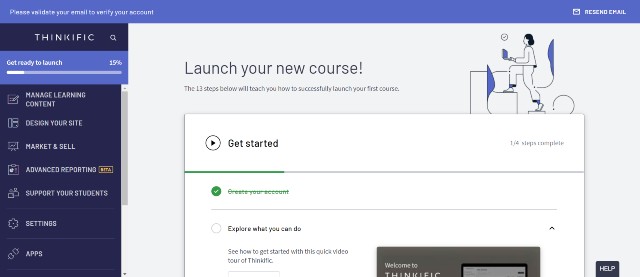
I find this tutorial extremely beneficial. It is interactive and gives me detailed instructions without the need to read a massive wall of text.
Integrations – You can integrate Thinkific with your favorite software, including Shopify, Google Analytics, email marketing tools, and many more.
If you are unsure whether Thinkific is right for you, you can register for a free account to create your course right away.
Pricing
Though technically you can use the free plan for life, it lacks essential features that will make your course distinguish itself from competitors.
If you aim to create a lucrative course, you need to invest in one of the three paid plans (all pricing below is for annual plans).
- Basic – $39 per month
- Pro – $79 per month
- Premier – $399 per month
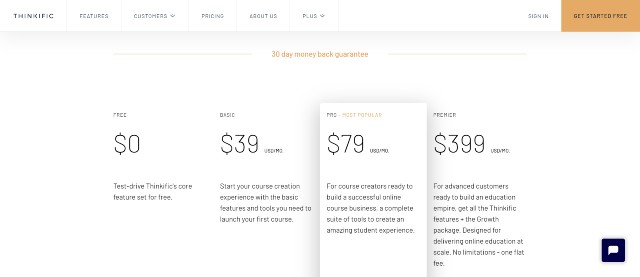
With all three plans, you can have unlimited courses and students. What makes each plan differ are the features.
The Basic plan provides access to all essential features. However, I don’t think you should use it because you cannot create live online classes, assignments, certificates, communities.
In addition, the plan also limits customization and pricing options. For instance, you cannot create a customized student experience and offer subscriptions as a pricing option.
With such limits, your course will lack depth and might prove highly challenging to satisfy students. Hence, I recommend skipping it and subscribing to the Pro plan instead.
The Pro plan will grant access to all features on the platform. Undoubtedly, this is the best option for most users.
The Premier plan will provide white-label services, advanced integrations, and the ability to add more instructors and course admins. Unless your online school has grown huge or had numerous courses in your arsenal, I don’t think you need this plan.
Pros and Cons
Pros
- Unarguably one of the best online course builder platforms
- Informative, step-by-step tutorial to help get started on online course creation
- Excellent interactive and fast course management platform with zero clunkiness and straightforward navigation (you can easily find the features you want).
- Comprehensive features and high flexibility: You can create and sell courses the way you desire.
- Easy-to-use: No programming language required
- Free account to try all basic features
- No transaction fees for all plans
- Create unlimited courses + Receive unlimited students
- 30-day money-back guarantee
Cons
- Several reviewers believe that some features, such as assignments, are too basic. They hope to create more advanced, in-depth assignments beyond multiple choices.
- Not SCORM-compliant
3. Teachable
Teachable is another robust company that provides comprehensive learning management systems. With Teachable’s highly efficient features, creating high-quality online courses would not be out of the question for anyone.

Key Features
On the Teachable platform, you can create two types of training: course and coaching. The latter is designed for 1-on-1 tutoring or an exclusive private live class that a student might request.
Online Course Creator – Teachable offers an excellent online course creation platform that allows everyone to create any course of their own choice.
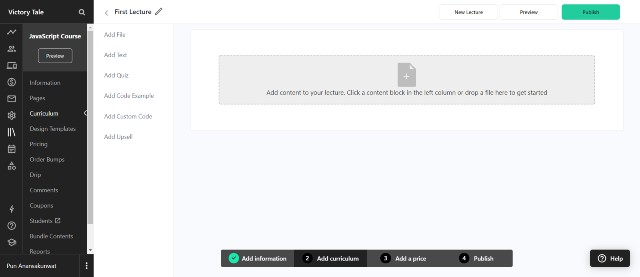
What you need to do is straightforward. You just need to fill in the blueprint with your learning assets, such as video & audio files, text, and assignments.
Programming instructors can also use an interactive code example editor to display a properly formatted code example in the lecture. As a programming student myself, this feature is hugely beneficial, as code examples help me understand the concepts much faster and easier.
Upsells – If you have created a private or personal coaching course, you can upsell it in your lectures, potentially adding an extra income to your pocket.
Drip – You can use this feature to add new lessons for each student over time, based on the days since the student’s enrollment. Hence, you can fully control the pace and provide an optimal learning experience for all students.
Design Templates & Website Builder – You can design the visual appearance of your course handily through design templates. Just select one of them and then customize the colors and typography. You can also add a logo & branding to make the course resonate with your brand voice.
Like Thinkific, Teachable has a built-in website builder that allows users to create a website to provide course information to prospective students.
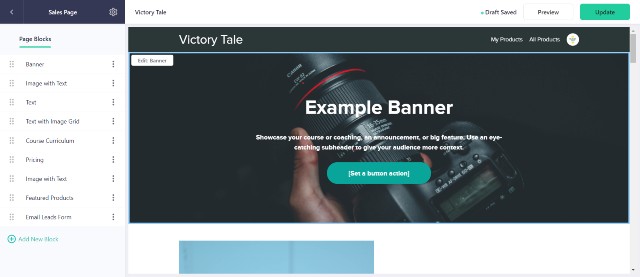
Through the drag & drop editor, you can handily add a homepage, a course page, multiple sales pages, a checkout page, etc., to facilitate students’ purchasing.
However, Teachable does not offer a varied selection of pre-built templates to choose from at all.
Suppose you want to create a new sales page. You have to start with the same template and manually change the elements to make the new page visually different from its predecessors.
In my opinion, the default template is not very appealing. Hence, your web pages can still be bland, while the design can look repetitive across all information pages despite your efforts.
On the other hand, if you don’t care much about design, Teachable’s site builder is decent to use. You can use it to create a professional-looking website within minutes.
Custom Domain – You can remove the Teachable subdomain and replace it with a custom domain you own.
Communities and Memberships – You can create several communities on the Teachable platform to offer students opportunities to communicate with the instructor and classmates.
Reports – You can view your statistics and grasp actionable insights from this dashboard.
Marketing and Pricing – Teachable provides plenty of marketing-related features that help bolster course sales, including multiple pricing options, coupon codes, and an affiliate program.
Step-by-Step Guidance and Quickstart Webinar – Teachable’s onboarding process is straightforward because the platform has easy-to-follow guidance and a Quickstart webinar. The latter is a 40-minute video that will introduce all features on the platform.
Regarding the guidance, it will explain the proper steps you should follow to create an online course. I think it is helpful, but not exceptional, as it is not interactive like Thinkific’s.
US and European Tax collection – Teachable automates US sales taxes and EU VAT collection and remission. Thus, you can focus on creating and maintaining your course without the need to deal with quarterly accounting work.
Integrations – You can integrate Teachable with the software of your own choice through native or Zapier integration.
Unlike other platforms, you can create an account and publish the course for free. I suggest you do so to try all its core features.
Pricing
As mentioned above, you can use Teachable to create and sell online courses without paying for a subscription. However, I do not recommend this option.
This is because Teachable will collect $1 per transaction and 10% transaction fees. The Free plan also has minimal features. The paid plans would thus provide more value for money.
Currently, Teachable offers three paid plans as follows (all pricing is for annual plans):
- Basic – $29 per month
- Pro – $99 per month
- Business – $249 per month
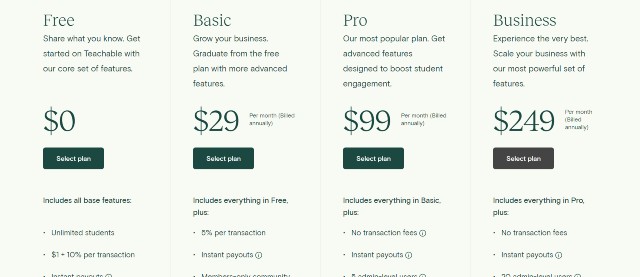
First of all, without hesitation, you should skip the Basic plan and subscribe to the Pro plan.
This is because this plan forces you to pay transaction fees as high as 5%, but you pay none if you upgrade to the Pro plan. Furthermore, the Pro plan also offers more advanced features that are extremely useful, including the following:
- Graded Quizzes
- Advanced Reports
- Certificate of completion
- Affiliate Program
- Removal of all Teachable branding
Subscribing to the Pro plan will save you money and make your online program more professional and unique. Thus, subscribing to the Pro plan is a no-brainer.
The Business plan would add advanced theme customization, bulk student enrollment, more admin-level users, and many powerful enterprise features. However, if your online school is small, these features will not be beneficial. The Pro plan would be sufficient in most cases.
Pros and Cons
Pros
- Best online course platform to create a programming course
- Unlimited courses and students for all plans
- Clean and fast user interface
- Beginner-friendly (coding skills not required)
- Support 1-on-1 tutoring or coaching
- Automate tax collection for US and EU residents
- You can create and sell courses online with the Free plan.
- Zapier Integration
Cons
- Provide a single pre-built template to create a homepage and a sales page, resulting in a static and bland design across all pages.
- Charge Basic plan users 5% transaction fees
- Not SCORM-compliant
4. Podia
Podia is more than just an online course platform. Essentially, Podia comprises five tools that work perfectly together to assist users in selling their educational products and services, particularly courses, private training sessions, memberships, digital downloads, and many more.

Key Features
With Podia, you can build your online school or even an educational juggernaut to sell products (both physical and digital) and services to students.
Online Course Builder – Like other platforms, Podia has a pre-built course structure that you can use right away. You just need to upload all your content. I think Podia’s builder is one of the most straightforward to use. I don’t think you will need any walkthrough at all.
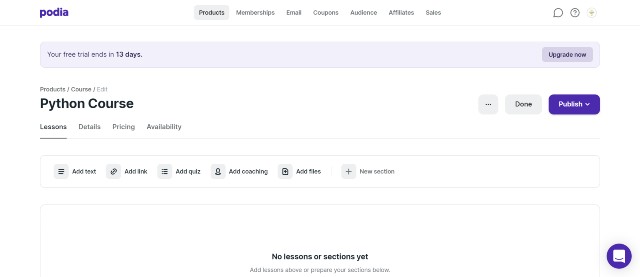
Webinar and Coaching Session – You can use Podia to sell exclusive access to your live online classes or 1-on-1 training sessions, all of which will be hosted on YouTube or Zoom.
Drip Courses – You can select the right time to release content to students, thus ensuring that their pace is optimal for their learning.
Pre-selling and Future Start Dates – You can create a pre-sell campaign to collect course fees even before launching online courses. Thus, you will grasp how your existing students evaluate this course idea and receive considerable funds to start the project.
Website with Custom Domain – Podia has a built-in site builder that can create all the pages for your website. However, it provides no pre-built templates or themes. You will need to start with a blank page and add the elements you need manually.
Though the process is straightforward, it can be challenging for those with no web design skills to create pleasing and professional sales pages.
Sales & Marketing Assets – Podia allows users to create various marketing assets on the platform, including coupons, bundles, and upsells to boost conversion rates.
Affiliate Program – You can create an affiliate program and gain new students from referrals.
Built-in Email Marketing Platform – Podia has a built-in email marketing platform that allows instructors to stay in touch with existing or prospective students. Thus, you will not need another third-party software to communicate with them.
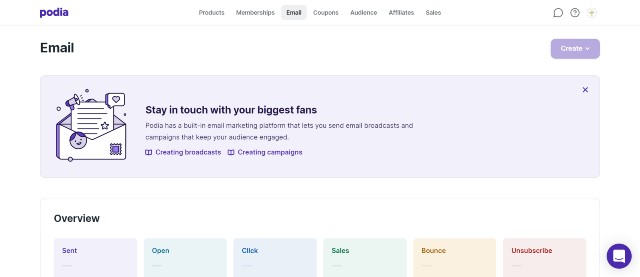
Live Chat – You can provide real-time support to your students through the chat widget on your website. Hence, your students will receive a timely response, enhancing their learning experience.
Integrations – Podia can integrate with other software through native or Zapier integration.
You can start a free trial to try all Podia features.
Pricing
As of September 2021, Podia has three pricing plans as follows (all pricing below is for annual plans):
- Mover – $39 per month
- Shaker – $79 per month
- Earthquaker – $179 per month
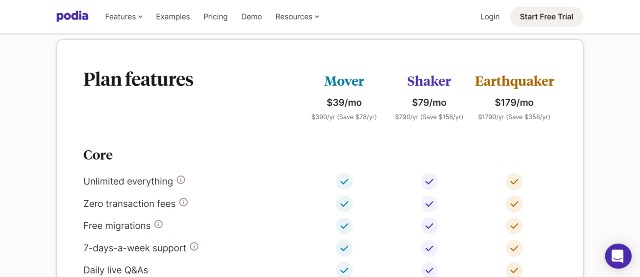
Podia charges no transaction fees and offers unlimited resources (courses, students, bandwidth, etc.) for all plans. Thus you don’t need to worry about it.
The Mover plan provides access to almost all features on the platform. You just cannot sell memberships, coaching sessions, or use affiliate marketing.
This plan is adequate for all beginners and small online schools who plan to create a straightforward self-paced course and use a one-time pricing option.
Shaker plan users can use all the features and sell coaching sessions and memberships on the platform. Also, you can send emails to 15000 recipients (compared to 5000 for the Mover plan).
However, at this pricing rate, I think other platforms that offer more features, such as LearnWorlds, are a better alternative.
Pros and Cons
Pros
- Effortless to use
- Clean and fast user interface
- Unlimited everything (Courses, Students, video hosting bandwidth, etc.)
- No transaction fees for all plans
- Support pre-selling
- Built-in email marketing software
- Live chat widget to engage with students and visitors in real-time
- Zapier Integration
Cons
- No free plan, but a 14-day free trial is available.
- No pre-built templates to assist in site design
- Decent video walkthrough
5. Xperiencify
Everyone likes games. They are entertaining and addictive. Games are the direct opposite of online courses that can literally function as sleeping pills.
However, if you can create an online course that is as entertaining as games, would that be perfect? Students will enjoy the “game” and learn good stuff along the way.
Xperiencify is a platform designed particularly for that task. All of its users can create a gamified course that students will love, and they might become your repeated customers once you publish a new course.
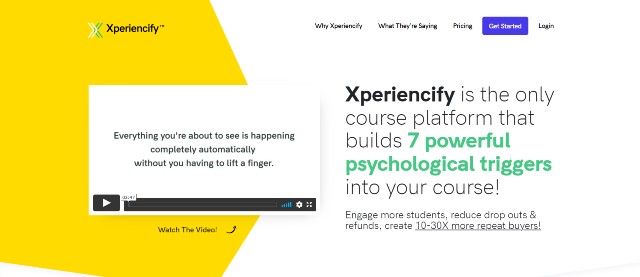
Key Features
Online Course Builder – Like other platforms, you can add course content by uploading your resources to the curriculum. You can add text, video, audio, and other multimedia as you wish.
Experiencification – This feature will gamify your entire course through the use of automation (known as the Experience Engine). Below is a summary of what “Experiencification” will add to your course.
- XP Points system – This system is similar to that of the most popular games. Students will obtain points after successfully performing a task.
- Leaderboards – Gamers always love to compete against each other. You can stimulate students’ competition by displaying leaderboards that showcase top performers.
- Celebrations and Sound Effects – Once students reach a significant milestone, the platform will send full-screen celebrations to their screens along with stunning sound effects.
- Countdown Timer – You can add a countdown timer to assignments or lessons, stimulating students to perform the task faster. This may be highly beneficial if you plan to create a test prep course.
- Additional Automation – You can use built-in automation to perform several tasks automatically, such as sending an email to recall inactive students back to the course.
Drip Content – You can customize the drip schedule in 7 ways. For example, you can release a new chapter immediately after students complete all prerequisites or earn at least 1000 XP points.
This would make your course unpredictable. Students will be surprised and might continue learning until the last lesson.
Site Builder – With this feature, you can create and customize a website to provide information and generate leads for your courses.
Xperiencify will provide a single pre-built template for designing your core web pages. However, there are no other additional templates to choose from. You will then need to add or remove elements manually.
Like other online course platforms, your site can also use a custom domain of your own.
Marketing – Xperiencify currently offers a few marketing features. You can create discount coupons, but you cannot recruit bloggers and influencers because the platform does not have a built-in affiliate program.
If you want to do so, you will need additional affiliate software.
Step-by-Step Guidance – Once you log in to the platform, Xperiencify will provide a step-by-step checklist to guide you through the entire process. I think the guidance is modest, though.
However, some advanced features such as Experiencification and automation can be challenging for users to set them up properly. If you need more explanations, you can access the help center at any time.
Integration and API access – Xperiencify can integrate with other tools mostly through Zapier. Alternatively, you can use API endpoints as well.
You can create a free account to try all the features (credit card required). However, you cannot publish or sell your course unless you subscribe to one of the paid plans.
Pricing
Currently, Xperiencify offers three pricing plans as follows (all pricing is for annual plans):
- Launch – $49 per month
- Growth – $149 per month
- Scale – $499 per month
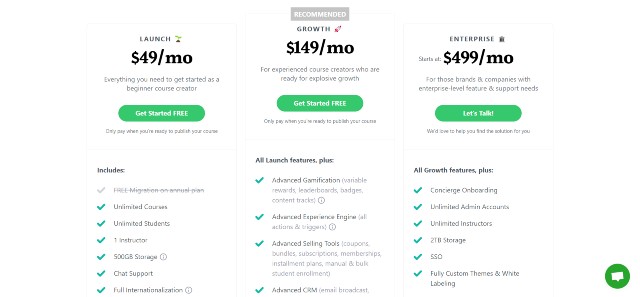
The Launch plan is inexpensive and provides access to all essential features (almost everything from the previous section) and Zapier integration. The only drawback is that you will need to pay hefty 4.9% transaction fees while paying none if you subscribe to higher plans.
As the Launch and Growth plans have a price difference of $100, it is pretty subjective on which plan is the best plan to choose between the two.
If you have not created any online courses before, you might want to start with the Launch plan that grants good features. Later on, you can upgrade to the Growth plan once your course sales go through the roof.
Those who have created online courses elsewhere can consider subscribing to the Growth plan, which grants all access to all features on the platform and API endpoint access.
Alternatively, you can subscribe to the Scale plan, which is expensive but would allow for complete customization of the online course. However, I don’t think this plan is necessary.
Pros and Cons
Pros
- Gamified course creation is revolutionary. The course content would be highly addictive and unpredictable, thus retaining students’ attention and curiosity much better.
- 50 automation to perform various tasks
- Clean, modern user interface
- Unlimited courses and students
- Advanced drip content with more options than all other competitors
- Zapier Integration and API endpoint access
Cons
- High entry price than most competitors + 4.9% transaction fees for the Launch plan
- Some features can be confusing at the beginning. There is some learning curve in using them.
- No built-in affiliate program (as of September 2021): You will need to pay for additional affiliate software if you need one.
- Do not offer a selection of pre-built templates to build a site
- Require a credit card to create a free account
6. iSpring
iSpring is the ultimate solution for online course building. Due to its immense features and eLearning assets, iSpring facilitates the creation of exceptional interactive courses that will offer marvelous learning experiences to students.
iSpring offers three key products: iSpring Suite Max, iSpring Learn, and iSpring Market. The first functions as a course authoring toolkit. The second is a learning management system (LMS). The third serves as a marketplace to sell and promote your courses to visitors.
iSpring Suite Max
Unlike other online course builders, iSpring Suite is not web or cloud-based. Hence, you will need to download the software and install it on your computer.
Once installed, iSpring Suite will integrate seamlessly with Microsoft PowerPoint. It will add a set of tools that you can use on the most right of the toolbar.
The next step is to use those tools to create and add your resources, including the following:
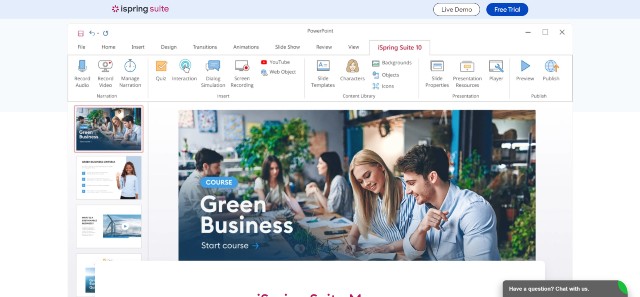
Audio and Video – iSpring allows users to record both audio and video, and add narration and annotation directly on PowerPoint. Once you have finished recording, you can use the built-in Video Studio to edit all your assets.
Thus, you can create the core content for your video course without the need to use third-party software.
Slides and other PowerPoint effects – You can use standard PowerPoint features in your course as usual. Feel free to add existing presentations, effects, and animations to offer students a more engaging experience.
Quizzes and Assignments – You can choose from 14 templates to design quizzes and assignments. These include multiple choices, drag-and-drop, matching, and many more. Hence, you will have the complete flexibility to select the assessment format that suits your content most.

In addition, you can set unique scoring rules, add branching scenarios, and allow randomization. Thus, every student will have a different experience every time they take the quiz, effectively preventing cheating in the process.
Dialog Simulations – This feature lets you turn existing scripts into interactive, role-play simulations, which is highly beneficial if you want to create language courses or training for employees who need to interact with clients.

The creation process is straightforward. Just select a character, build a scenario, and drag-and-drop your scripts.
iSpring Content Library – Packed with 2300 slide templates, 81000 character images, and 2500+ location images that you can use in your course at will, this content library can speed up the workflow and save costs on required course assets.
iSpring Space – This feature offers a central online space that allows teams to collaborate and build the course together. Furthermore, you can add additional course assets for the LMS on the platform as well.
You can try iSpring Suite Max free for 30 days.
iSpring Learn
iSpring Learn is an excellent LMS that allows your students to access the course content online. Below are some of its key features.
Integration with iSpring Suite – Both iSpring software integrate seamlessly with each other. Hence, you can publish your iSpring Suite course within one click.

Longread – Longread functions as a basic course builder. You can add texts, images, videos, or even quizzes directly on the LMS.
In other words, Longread is similar to Teachable and Thinkific’s course builder. However, it will not have the advanced course creation features of the iSpring Suite.
For example, I can create a Calculus course from scratch.
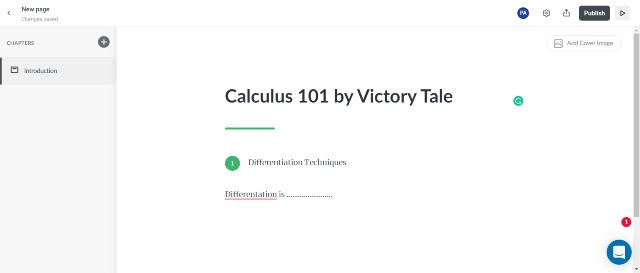
Learning Track – You can create a learning track for your students to progress in an optimal order, which will help them digest the course content better.
Gamification – Like Xperiencify, you can award points and badges to students once they complete the assignments and display a list of top performers on the Leaderboard.
Training Management – With this feature, you can assign specific course content to a particular group of students or enroll them directly in suitable training courses. Thus, you can ensure that all students access the right training program.
Web Meetings – iSpring Learn integrates natively with Zoom so that you can host a web meeting or a live online session for students right from the LMS.
This feature is optimal for users who want to create exclusive live online courses.
Customizable Design – You can customize your LMS at will. You can add your logo & branding and change fonts or colors to make the platform resonate with your brand voice.
In addition, you can translate the entire learning portal into any other language (Chinese, Russian, etc.) to reach a larger group of audience.
Mobile App – You can build a fully branded mobile app for students to save courses and take them offline.
Reporting – iSpring Learn will collect all the data on the platform. You can track students’ activities, and view progress reports, content performance reports, quiz reports, and many more. Therefore, you can use this data to conduct data analysis to generate actionable insights.
Start a 14-day free trial to try iSpring Learn by clicking the link below.
iSpring Market
Marketplace – With iSpring Market, you can create a marketplace to sell your online courses and training. You can fully customize the look and feel to reflect your brand.

Marketing Tools – You can give out coupons or offer free courses to attract more students.
Customized Payment Terms – You can set prices in 30+ currencies and receive payments via PayPal or Stripe.
Reporting – iSpring will collect all the visitor data, including web traffic and purchases.
Zapier Integration – iSpring Market can integrate with Zapier. Hence, you can use your favorite online marketing tools to boost conversions and communicate with prospects.
You can use iSpring Market free for 14 days.
Pricing
iSpring uses a no-frills pricing structure. All three software products are priced separately. You will only pay for what you need.
- iSpring Suite Max – $970 per year (or $80.83 per month)
- iSpring Learn – starting at $3.66 per active user per month (for the first 100 users)
- iSpring Market – starting at $77 per month for 500 active users
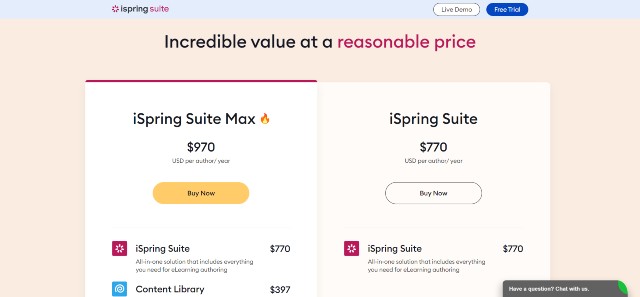
Active users are students who log in at least once during the month. For example, suppose 100 students log in to the platform in March. In this case, you will pay 3.66 x 100 = $366.
Apparently, both iSpring Learn and iSpring Market are not cost-effective, especially if you have thousands of students and visitors.
Therefore, I suggest subscribing to iSpring Suite Max to gain access to its top-notch course creation tools and using other LMS that have a fixed pricing structure (such as LearnWorlds) to go live and sell your courses.
Since iSpring Suite Max supports as many as 150+ LMS, this will not cause an issue at all. This strategy alone can save thousands of dollars off your course fees.
Pros & Cons
Pros
- Unarguably, iSpring offers the most advanced and comprehensive online course builder, thus suitable for large projects.
- Fast and modern user interface
- Offer numerous features and assets to create an exceptional online course
- All courses created with iSpring are responsive. Thus, they display perfectly on every screen size.
- iSpring Suite integrates seamlessly with 150+ LMS, including iSpring Learn
- SCORM Support
- 24/7 Technical Support
- 30-day free trial (no credit card required)
Cons
- Not cost-effective compared to other alternatives
- No built-in affiliate program
7. LearnDash
Unlike others on the list, LearnDash is not a standalone online course platform. Instead, LearnDash functions as a WordPress plugin that helps WordPress users create and sell online courses on their websites.
Hence, if you have a WordPress website with excellent hosting, LearnDash is a promising online course builder that you may want to consider.

Key Features
Drag & Drop Course Builder – LearnDash has prepared you with a course structure. You just upload the file you need and drag & drop them to form a course.
Advanced Quizzing and Gradebook– LearnDash allows up to eight types of assignments. You can create multiple choices, fill in the blanks, sorting problems, or even essays and open-ended questions. This equips you with suitable options to provide a comprehensive student evaluation.
You can also create a Gradebook to see their grades on specific subjects. This feature is excellent if you want to help struggling students before they abandon the course.
Drip-feed Lessons and Prerequisites – You can completely control how your students access your course content. For instance, you can release exclusive content on a specific date or grant access only when students score higher than 90% on the previous assignments.
Course Points and Leaderboards – With LearnDash, you can gamify some of your course elements as Xperiencify, albeit not as advanced. You can grant learners course points and display leaderboards to show top performers.
Certificates and Badges – You can grant students certificates and badges once they reach the milestone.
Forums – You can create forums for students to exchange opinions and ask questions.
ProPanel Enhanced Reporting – You can grasp how your course performs in real-time through this feature. With a single dashboard, you can run reports on several metrics, manage assignments, view student course progress, and many more.
Essentially, this feature helps simplify the course management process, saving hours of your valuable time.
Integrations – You can integrate LearnDash with other apps through native integration or Zapier.
Important Note for Beginners
LearnDash functions as a Learning Management System (LMS), like iSpring Learn. Thus, the platform does not offer all-in-one course creation solutions like others on this list. You will need other plugins to perform the following tasks:
| Tasks | Recommended Plugin/Software |
| eCommerce and Shopping Cart | Woocommerce (free) |
| Landing page and Sales Funnel | Elementor (free, paid) or Unbounce (paid) |
| Affiliate Program (optional) | Affiliate WP (paid) |
| Interactive Content (optional) | Outgrow (Paid) or Spott.ai (Paid) |
Suppose you are a beginner and have never subscribed to all paid plans for the above plugins and software. The total cost of hosting the course on your WordPress website (including high-quality hosting fees) might far exceed hosting it independently (in other words, replacing LearnDash with LearnWords, Thinkific, etc.).
Therefore, it is vital to consider these options prudently before making decisions. In many cases, you may be much better off (both cost-wise and quality-wise) by hosting the courses independently.
Pricing
LearnDash does not offer a free plan. You have to choose from one of the three following plans.
- Basic – $159 for 1-year support and update
- Plus Package – $189 for 1-year support and update
- Pro Package – $329 for 1-year support and update
Once you purchase the plugin, you can use it indefinitely. However, LearnDash will terminate support and plugin updates unless you renew the plan. So technically, the pricing structure above is similar to an annual subscription.
I suggest you skip the Basic plan and subscribe to the Plus Package plan instead. This is because the former does not grant access to the innovative ProPanel Enhanced Reporting, which significantly smoothens the course management process.
The Pro Package is entirely unnecessary unless you want to create courses on more than 5 WordPress websites. Therefore, the Plus Package is undoubtedly the best plan that most users should subscribe to.
Pros and Cons
Pros
- The best learning management system for WordPress
- Straightforward to use + Clean user interface
- Eight types of assignments
- Gamify some essential course elements
- If you already have the required plugins and excellent hosting, LearnDash is an inexpensive way to create and sell online courses compared to other alternatives
- SCORM-compliant (you need to install a paid third-party add on, though)
- 30-day money-back guarantee
Cons
- Since LearnDash is a WordPress plugin, students will use your server resources. Thus, you need to make sure that your server is high-quality and has abundant resources. Otherwise, students’ learning experience will be poor.
- You will need other plugins to create a sales funnel and an affiliate program for your courses.
- No free trial
Other Alternatives
Teachery – If you value simplicity and don’t plan to use flashy features at all, Teachery might be the one that you should seriously consider. This platform delivers a set of features that help you earn money from your talents.
However, unlike online course platforms, you will not host most of your learning assets on Teachery (except text).
You will need to upload your assets to other platforms such as Youtube or Soundcloud and embed the code into your course on Teachery, which I think is not optimal. Its features are also limited compared to competitors with the same pricing range and unlimited video hosting.
Therefore, I don’t think Teachery is the best online course builder you could find.
Systeme.io – Systeme is an all-in-one growth marketing platform. You can use it to create an introductory online course to generate awareness of your brand or products.
However, its features are much more limited than actual online course platforms. Hence, I think it is only suitable for marketers but not educators.
Ruzuku is another online course platform that offers a full suite of features to help you create online courses to share your skills with the world.
However, its platform is relatively slow and clunky. I have encountered several events of unresponsiveness since I first registered for a free account. The user interface is also outdated. Therefore, other course platforms provide a much better value for money at the same price.
Kajabi – Like Podia, you can create and sell online courses, private training, and other educational goods and services through Kajabi.
However, Kajabi’s starting price is high ($119 per month). It also limits the number of products you can sell, while its features are not exceptional compared to others at much cheaper pricing. Hence, I think those on the list are apparently better options than Kajabi.
Academy of Mine – Academy of Mine is a full-fledged LMS (learning management system). Besides providing comprehensive features, the platform is SCORM-compliant.
Thus, you can import SCORM courses created using popular authoring tools (Adobe Captivate, Articulate, iSpring, etc.) onto the platform.
However, Academy of Mine’s entry price is extremely high, starting at $499 per month. It may not be optimal for individual instructors or SMBs.